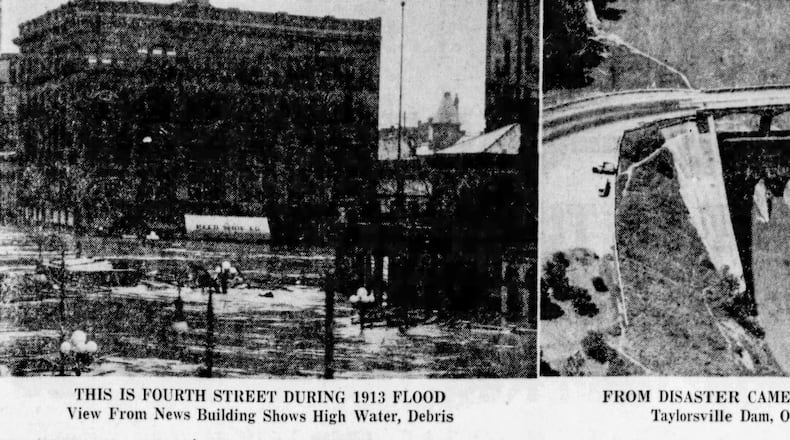For more than a century, Dayton was tormented by its uncontrolled rivers. A serious flood in 1805 prompted a proposal to move the community to higher ground. Flood in 1814, 1832, 1847, 1866 and 1883 were practically forgetting when that of 1913 devastated the city.
Beginning Sunday, March 23, a tremendous four-day storm ravaged the Miami Valley. Hemmed in by high pressures to the east, the storm let loose all the elements of destruction commonly distributed piecemeal across half the continent. More than 7 inches of rain fell here in 24 hours. In some Miami Valley areas the total was 11 inches.
Levies dating back to 1847 couldn’t protect the city. At 7 a.m. Tuesday water was slopping over the Miami riverbank at the head of Jefferson St. An hour later it poured down the streets. By noon it was a mighty torrent nearly four miles wide.
Judge Walter D Jones of Piqua, marooned in the Beckel hotel, watched “the seething foaming torrent rolling down Jefferson street to a depth of more than 12 feet.”
HE NOTED chairs, tables, counters, shelves, pianos and struggling horses in the current. “A sickening sight of ruin and destruction,” he later described it.
On the north side of 3rd St, between Jefferson and St. Clair, every building but one was destroyed by fire. There were, of course, many smaller fires that multiplied the misery and apprehension of citizens.
Gen. George H. Wood, Adjutant General of Ohio who had been sent to Dayton by Governor James M. Cox, reported: “AT daybreak Thursday I found that the water had fallen so that Main St as far South as Second was practically dry, but the scene of desolation was terrible. The asphalt paving on 1st St had been torn from the foundation in sheets. The streets were covered with mud and huge bars of gravel and wreckage were everywhere. The plate glass windows had been swept from the stores...After conferring with judge Carroll Sprigg of the Common Pleas and Judge Roland Baggott of Probate, upon their request I assumed government responsibility and declared martial law.”
That 1913 flood was more destructive than any that preceded it. In the Miami Valley, 361 persons were killed. Property losses in the valley exceeded $140 million in Dayton, more than $67 million.
The redeeming factor during and after the disaster was local leadership. Orville Wright wrote in April of that year, “I do not suppose there has ever been a similar calamity where relief was so promptly afforded with so little waist. Dayton was fortunate in having a man with the ability of John H Patterson to take his work in hand.”
WORKMEN at the national cash register Co. built boats to rescue trapped persons. NCR buildings were transformed into a relief center for thousands of flood victims.
Before the mud and filth, the debris and dead animals, had been removed from buildings and streets, Patterson sparked the idea of a flood control project.
A group of leaders, in a 10-day period, rounded up pledges of more than $2 million to launch an engineering study. Hesitant citizens were admonished to remember the promises they had made in their attics during the height of the flood.
A search for the best flood control engineer turned up Arthur E. Morgan. His quick survey of the Miami watershed showed that an adequate project would involve portions of nine counties - Montgomery, Miami, green, Clark, Shelby, Prebble, Warren, Butler and Hamilton. Dad called for the creation of a Conservancy district with power to implement its decisions.
The Conservancy measure, drawn up by Dayton attorney John A. McMahon, was piloted through the Ohio legislature by Governor Cox. It established a new political subdivision which withstood numerous court attacks instituted by opponents of the project.
Half of the 10 years required to complete the work was consumed in overcoming legal barriers thrown up by well meaning but misguided persons. It was Col. E. A. Deeds, organizer of the project, who took the brunt of the criticism and abuse voiced by the majority.
THE ENGINEERING plans were checked and rechecked by the most competent experts available. Nothing was left to caprice or chance. Before a shovel of dirt was turned, Morgan and his associates knew they had solved the problem.
The project involved the construction of five dams, relocating about 55 miles of railways, many miles of highway and wire lines, the moving of Osborne village to a new site, lowering of water and gas mains and improving of miles of levees and river channels.
The system was designed to be automatic. Human judgment was never to enter into operation of the plan. The outlet conduits of the five dams were planned to release only the maximum flow that could be put safely into the river channels through the cities.
In ordinary times, they carry the entire stream flow. Incidentally, the dams were designed to hold back a flood 40% greater than that of 1913.
Col. Deeds called the project “the most important single responsibility of my career. The best years of my life were devoted to it. The spirit of The Pioneers who settled the Miami Valley came to the fore.”
Governor Cox observed: “Nothing can ever be more to the credit of the citizens of the Miami Valley than their execution of the project without government aid. Their self reliance stands in marked contrast with the use of tremendous sums of federal money in recent years to carry out such enterprises in various parts of the country.”
Morgan concluded: “The most significant aspect of this undertaking cannot be covered in a technical report. For it was the spirit of the community, no less than careful planning, which made possible the final success.”
About the Author


